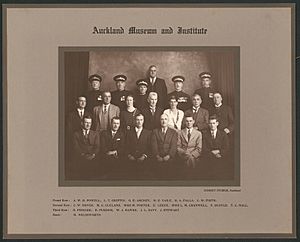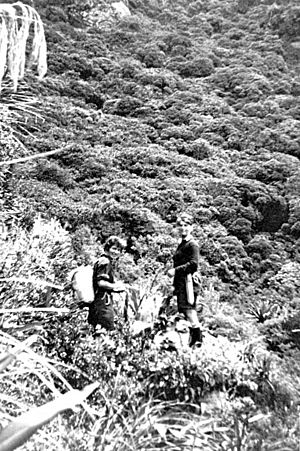Lucy Cranwell facts for kids
Quick facts for kids
Lucy Cranwell
FRSNZ
|
|
|---|---|

Cranwell, c. 1930s
|
|
| Born | 7 August 1907 Henderson, New Zealand
|
| Died | 8 June 2000 (aged 92) |
| Nationality | New Zealander |
| Alma mater | University of Auckland |
| Known for | |
| Scientific career | |
| Fields | |
| Institutions | Auckland Museum, University of Arizona |
| Author abbrev. (botany) | Cranwell |
Lucy May Cranwell (7 August 1907 – 8 June 2000) was an amazing New Zealand botanist. She did groundbreaking work in a field called palynology, which is the study of ancient pollen.
Lucy Cranwell became the curator of botany at Auckland Museum in 1929 when she was only 21 years old. Besides her important research on old pollen, she also helped many children in Auckland learn to love plants.
Contents
Early Life and Education
Lucy Cranwell was born in Auckland, New Zealand, in 1907. She grew up in Henderson, on a fruit orchard. Her mother loved nature and art, and her father was a skilled gardener who planted many trees.
Lucy went to Henderson public school and then Epsom Girls Grammar School. In 1925, she started studying at the University of Auckland. She earned a degree that combined English and Botany. Later, she got her master's degree in Botany in 1929. Her master's research was about plants that grow on other plants, called epiphytes, in the Waitākere Ranges.
During her university days, Lucy loved tramping, which is like hiking. She was known as the strongest and fastest walker in her university's field club. This love for the New Zealand wilderness was very helpful for her many botany trips. She often explored remote parts of the country with her friend and fellow botany student, Lucy Moore.
Working at Auckland Museum
In April 1929, soon after she graduated, Lucy was offered a special job. Dr. Gilbert Edward Archey, the director of the Auckland Museum, asked her to be the first Botany Curator. The museum was moving to a new, much bigger building that year. Lucy's job was to fill its halls with plant displays.
She also organized the Cheeseman herbarium, which held about 10,000 dried plant samples. During her 14 years as curator, Lucy did a lot for the museum and for children. She started "botany trots," which were guided walks for kids to places like Rangitoto Island. She also wrote weekly articles about plants for children in the Auckland Star newspaper. In total, she collected over 4,000 plants for the museum's collection.
Exploring New Zealand's Plants
Lucy Cranwell was one of the first women scientists in New Zealand to do so much field work. Her trips were very extensive. She explored ancient forests in the King Country, looking for root parasites. She also visited Te Moehau peak on the Coromandel peninsula many times to study the special alpine flora that grows there. She made several visits to Maungapohatu in Te Urewera.
Lucy also studied marine algae (seaweed) around New Zealand's northern islands. Two types of algae are even named after her! She surveyed Auckland Harbour and its west coast. She also traveled to the South Island to collect fossil pollen samples from bogs.
Field trips in the 1920s and 1930s were very challenging. Lucy and her friend Lucy Moore often slept outdoors in canvas sleeping bags. Sometimes they woke up covered in frost! Because of her experiences, Lucy became a strong supporter of conservation. She realized early on that animals like possums and wallabies were a serious threat to New Zealand's native forests. In 1940, Lucy published The Botany of Auckland, which was the first complete guide to the plants in the Auckland Region.
Discovering Ancient Pollen
During a trip to Europe in 1935, Lucy attended a big meeting for botanists in Amsterdam. There, Professor Lennart von Post from Stockholm invited her to learn his method of analyzing fossil pollen. This new field of study is called palynology.
With this new knowledge, Lucy Cranwell opened up a whole new area of botany in New Zealand. By analyzing pollen found in the mud of bogs, she could figure out what plants grew in New Zealand long ago. This helped scientists understand New Zealand's past, including its connection to the ancient supercontinent called Gondwana.
In 1937, Lucy was made a Fellow of the Linnaean Society in London. This was to recognize her important plant research in New Zealand and Sweden. It also honored her efforts to make more people interested in botany through her work at the Auckland Museum. In the same year, she won New Zealand's top conservation award, the Loder Cup. In 1954, she received the Hector Medal from the Royal Society of New Zealand, becoming the first woman to ever get this honor.
World War II and Family Life
During World War II, Lucy Cranwell helped with the war effort. She researched and wrote a booklet for Allied airmen who might crash in the Pacific. It was called Food is Where You Find It: A Guide to Emergency Foods of the Western Pacific. The booklet showed, with pictures, what fish and plants downed pilots could eat to survive. It was very popular, and 5,000 copies were printed initially, followed by many more. Lucy also suggested to the Ministry of Works that certain plants like wattle trees, pampas grass, and nasturtiums should be planted across New Zealand. These plants could be used as emergency food for people and animals.
In 1943, Lucy married Captain Samuel Watson Smith from the US Airforce. He was a lawyer and later became an important researcher in archaeology. In 1944, Lucy moved to Arizona in the United States. They had one son, Benjamin Watson Smith. After working at Harvard University, Lucy became a research affiliate in palynology at the University of Arizona, Tucson. She became famous around the world for her work in this field, especially studying tiny plant fossils from Gondwana. Even after moving to the United States, Lucy remained very interested in New Zealand plants. She became one of the first supporters of the Waitākere Ranges Protection Society in 1973.
Recognition and Legacy
Lucy May Cranwell Smith was chosen as a Fellow of the Royal Society of New Zealand in 1944. She was only the second woman to receive this special award. In 1992, the University of Auckland gave her an Honorary Doctor of Science degree.
In 2017, Lucy Cranwell was honored as one of the Royal Society Te Apārangi's "150 women in 150 words". This celebrated the important contributions of women to knowledge in New Zealand.
The New Zealand Association of Scientists now gives out the Cranwell Medal. This award goes to a scientist who is excellent at explaining science to the public. In 2017, this medal was renamed from the Science Communicator Medal to honor Lucy Cranwell. She was a remarkable science communicator at a time when it was very unusual.
Lucy's childhood home in Henderson was given to Waitakere City by her family. It is now the location of Cranwell Park, a place for everyone to enjoy.
A native New Zealand grass, Festuca luciarum, is named after both Lucy Cranwell and her friend Lucy Moore. There is also a tramping track at Anawhata on the west coast of the Waitākere Ranges named after Cranwell, as she was a passionate supporter of the area.
See also
 In Spanish: Lucy Cranwell para niños
In Spanish: Lucy Cranwell para niños



